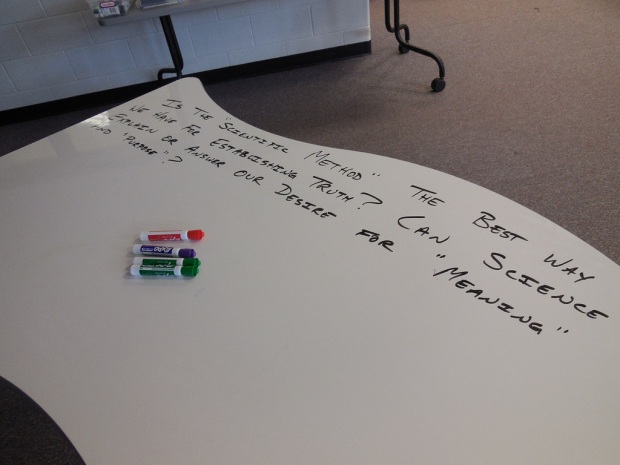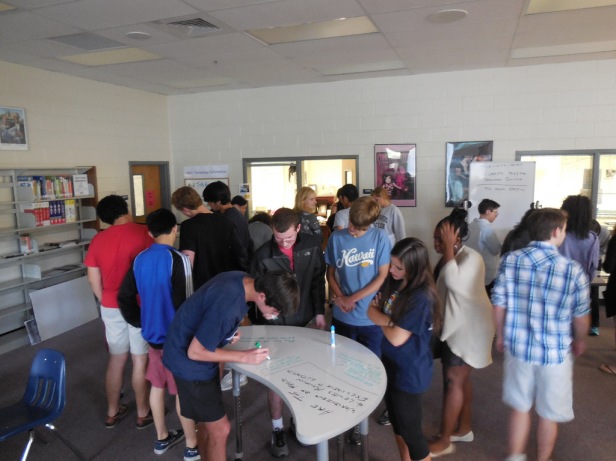Yesterday I blogged about the use of our new markerboard surface tables as a way for students to collaborate and capture their group thinking. I’d like to briefly share another use of these dry erase surfaces in our library learning studio from last week with our Theory of Knowledge (TOK) students. This was an activity that came together very quickly Thursday morning and while not tied to a formal research project, threads of inquiry were essential to the learning experience. The group came to the studio to watch a short clip of a PBS video related to their content/unit of study. Dr. Glenn and Mr. Byrne developed discussion questions around this segment and composed them on our dry erase surfaces.
After watching a short segment of the video, students had approximately 10-12 minutes to visit each table; students were encouraged to discuss their thoughts and reflections with their peers and then jot down their responses. We also observed students continuing the conversations around the written responses as they engaged in some truly meaningful and deep dialogue with each other.
Students were able to jump into the activity quickly and confidently and participate in richer, more nuanced conversations (both written and oral) because Dr. Glenn and Mr. Byrne consistently integrate learning/thinking structures as a regular part of classroom life. As I watched these students immerse themselves into the learning activity with depth and intensity, I could not help but think of the huge participation gap that Jennifer and I have observed the last two years. We have seen a wide range of academic and social skill sets across multiple content area classes, course levels, and grades; I feel I have struggled to articulate what I’m observing and to contextualize it although the recent readings are helping me to take first steps in doing so. The academic discourse and social behaviors of the TOK students were reflective of the academic literacy framework I referenced in yesterday’s post; in particular, these students were demonstrating:
1. Disciplinary literacy: “…the join understanding of discipline-specific literacy features through which knowledge is created and practices are shared” (Kiili, Mäkinen, and Coiro 225).
2 Argumentative literacies: “As students work to establish themselves as contributing members of a domain-specific discourse community, argumentative literacy practices enable them to consider alternative perspectives, broaden and deepen their knowledge, and make judgement to inform their decision making. As a result, students are able to identify, evaluated, and produce arguments within a wide range of individual and social literacy events…students are able to effectively composed, evaluate, and learn from arguments by adopting the social practices of the target discipline” (Kiili, Mäkinen, and Coiro 225).
3. Collaborative literacies: “…those literacy practices in which two or more person engaged in reading and/or writing together are equally responsible for negotiating meaning through talk. The goal of collaborative literacy practices is to produce a joint interpretation of a text” (Kiili, Mäkinen, and Coiro 225). In this case, our texts were previous knowledge and the PBS video segment.
Like many other activities we’ve helped design and/or facilitate this academic year, common threads are woven into learning activities:
- Writing as a medium for thinking and sharing
- Collaborative conversations
- Individual work, small group discussion, and large group share
We then moved to a large group discussion facilitated by Dr. Glenn; students from each table had the opportunity to share their thoughts about the question posed at their table.
Because we ran out of time, the activity was continued into the next day. Many students captured the ideas on each table with their cell phones as they prepared to leave for lunch.
Reflections: The Library as Learning Studio and Site of Literacy Practices
While not a formal research type of activity or project, we love working with teachers and students to provide them space and assistance for these kinds of learning opportunities. So often we call the library the “biggest classroom” in a school, yet learning experiences are often limited to formal research projects and/or storytime. In many schools, it’s a challenge for teachers and administrators to see the library as an additional learning space that can accommodate many kinds of experiences because the quiet, book-centric model and/or prior experiences dominate their perceptions. In other school libraries, limited budgets and restrictive physical space hinder the efforts of librarians to sell the library as a studio and alternate kind of classroom. When our spaces are designed with flexible areas that can be repurposed quickly, mobile furniture, and technologies for multiple modes of learning (low tech and high tech), the library can support a more diverse range of learning experiences and be better positioned to support the growth of academic literacies for all students throughout the school year, not just when it is time for formal or informal research projects. These learning space design drivers expand the possibilities of libraries as sites of practice for multiple literacies and can potentially position the library as a “commonplace for interpretation” in exploring, expanding, and theorizing the literacy practices within its learning community (Sumara), hence shifting and expanding the role of the librarian as a sponsor of literacy (Brandt).
References
Brandt, Deborah. Literacy in American Lives. Cambridge: Cambridge UP, 2001. Print.
Kiili, Carita, Marita Mäkinen, and Julie Coiro. “Rethinking Academic Literacies.” Journal of Adolescent & Adult Literacy 57.3 (2013): 223-32. Professional Development Collection [EBSCO]. Web. 25 Apr. 2015.
Sumara, Dennis J. Why Reading Literature in School Still Matters: Imagination, Interpretation, Insight. Mahwah, NJ: L. Erlbaum, 2002. Print.
Note: If you are interested in the “Rethinking Academic Literacies” article, you may also enjoy teacher Gary Johnston’s series of blog posts on this article.









An excellent post. Thank you for sharing the great work being done!
LikeLike
Thank you so much!!!
LikeLike